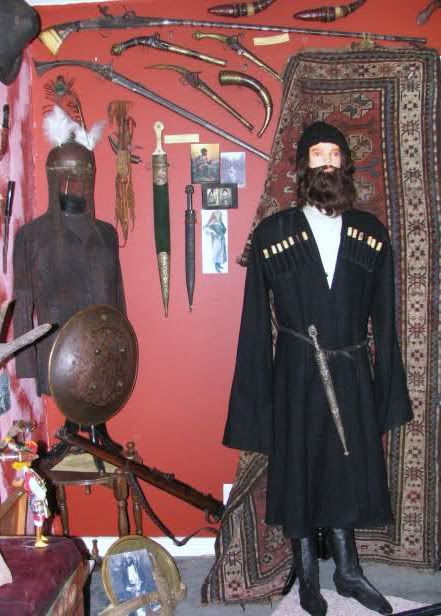
 |
|
|
|
|
#1 | |
|
Member
Join Date: Aug 2009
Posts: 63
|
Quote:
On a similar note, there's a dealer in Portobello with an Afghan (Tajik?) embroidered saddle jezail sheath that's utterly beautiful, and would quite fit my (heavily prettified) jezail, but his stall's been shut for weeks... If any London-based members are interested in textiles, there's an amazing small shop on Islington Green- Uzbek chapans etc, mid-1800s. The owner held an exhibition (and wrote the catalogue, which I own) for the V&A. Quite spectacular. edit: and don't get me started on suzanis... oy... |
|
|
|

|
|
|
#2 |
|
Member
Join Date: Dec 2004
Posts: 755
|
I have only one combination between weapons and textiles and this is one of my best kampilan.
Thanks carlos |
|
|

|
|
|
#3 |
|
Member
Join Date: Dec 2004
Location: Inland Empire, Southern California USA
Posts: 160
|
I have placed a rug from the Caucasus on the wall behind my Cherkeska : the traditional outer garment of the Caucasian tribesmen, worn by Kuban and Terek Cossacks, in this weapon and textile display.
Some of the symbolism seen on the rug. Ram's Horn - Sheep and rams were a vital source of warmth and comfort, as well as being central to the livelihood of the tribe. Their wool was the primary material used in weaving, which they considered a sacred activity. Throughout history, the ram's horn has been used to summon the group together as one. The ram's horn symbolizes strength, power and fertility, suggesting that life itself is not temporary, but eternal. Star of Wisdom - The eight-pointed star is an archetypal symbol that appears in cave drawings and likely stems from the dawn of mankind. This motif depicts man's potential for inner wisdom and understanding; in fact King Solomon wore an eight-pointed star on his ring as a reminder of inner striving. The tribal weavers lived an elemental lifestyle with minimal possessions. They believed that wisdom was the true wealth that could be obtained through the striving one made amidst the many challenges of one's daily activities. Thanks to Claremont Rug Company for symbolism info. 
|
|
|

|
|
|
#4 |
|
Arms Historian
Join Date: Dec 2004
Location: Route 66
Posts: 10,730
|
Thank you so much for the response Rumpel! Yes it indeed was Sheila Payne, and now that you mention it, the book was very much intended for very general audience and, entertaining, I suppose somewhat in 'Indiana Jones' fashion. Not a bad thing, but not entirely helpful from the perspective I was then seeking.
Intriguing notes on the Central Asian stuff there, and these vendors sound fascinating as I imagine the things you must have access to finding!!! There definitely is a lot to be discovered in aligning these material culture symbols with weaponry and accoutrements of these regions, and I really look forward to more discussion. Naga, thats exactly what we're talking about!and thank you for sharing those key notes on symbolism in these rugs (absolutely fantastic grouping there of weapons, and especially with the dimension added with the rugs).It is to me patently impossible to be in the presence of these kinds of rugs without imagination and resulting temporal adventures getting the best of me  Jose, speaking of adventures! Very, very nice grouping there as well, and its great to see these variations in them carrying the same comprehensive effect. Wow!  Carlos, a beautiful kampilan, and again, this addition of the material and bells represent important talismanic symbolism. Very nice example and thank you for sharing it. All the very best, Jim |
|
|

|
|
|
#5 |
|
Member
Join Date: Dec 2004
Location: What is still UK
Posts: 5,935
|
This cloth is a real silk one not rayon. Must have belonged or presented to a VIP.
|
|
|

|
|
|
#6 |
|
Arms Historian
Join Date: Dec 2004
Location: Route 66
Posts: 10,730
|
In our careers in the airline industry, my wife and I often had great opportunities to meet many people from many cultures. My wife had a management position in which she handled certain employee affairs, and one man needed to return to his home in Africa as his mother had passed away.
When he returned, in gratitude for my wifes handling of details to help him in making this trip, he very ceremoniously presented her with a bolt of cloth very similar in some of the colors Tim has shown. I cannot recall details on tribe or country, but what was important was that the cloth itself was offered with far more reverence than afforded simply to an everyday textile, and with extremely deep gratitude and reverence. It seems clear that in many cultures, the reverence for material culture is often well placed in many forms, and our true understanding of these offer important dimension to learning more on the weapons they used. All best regards, Jim |
|
|

|
|
|
#7 |
|
Member
Join Date: Oct 2008
Location: between work and sleep
Posts: 731
|
Atayal traditionally wove with rammie - a very laborious process.

|
|
|

|
 |
|
|